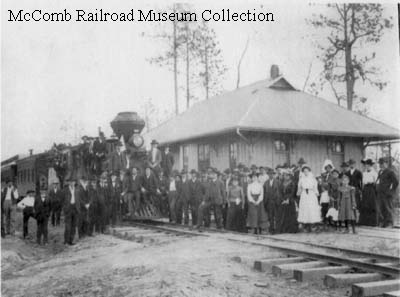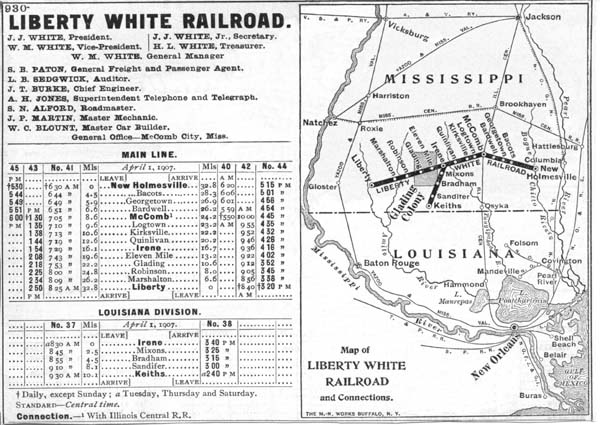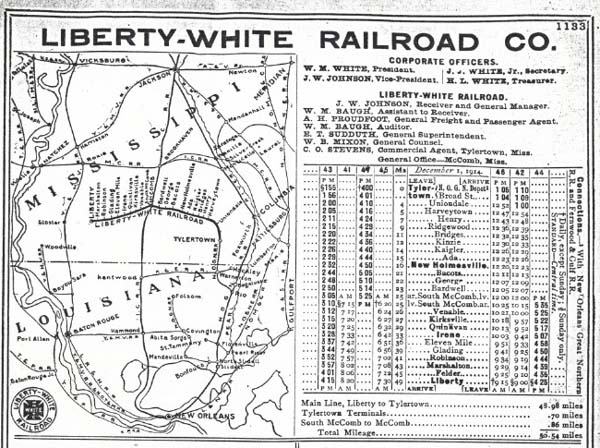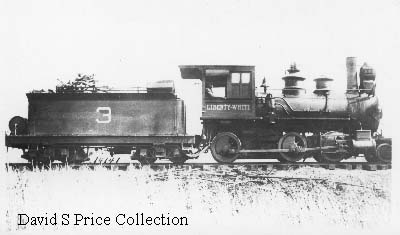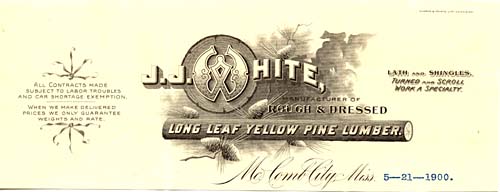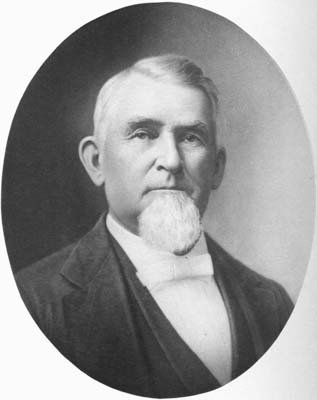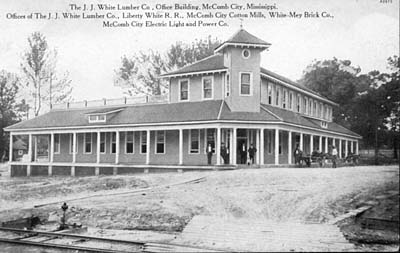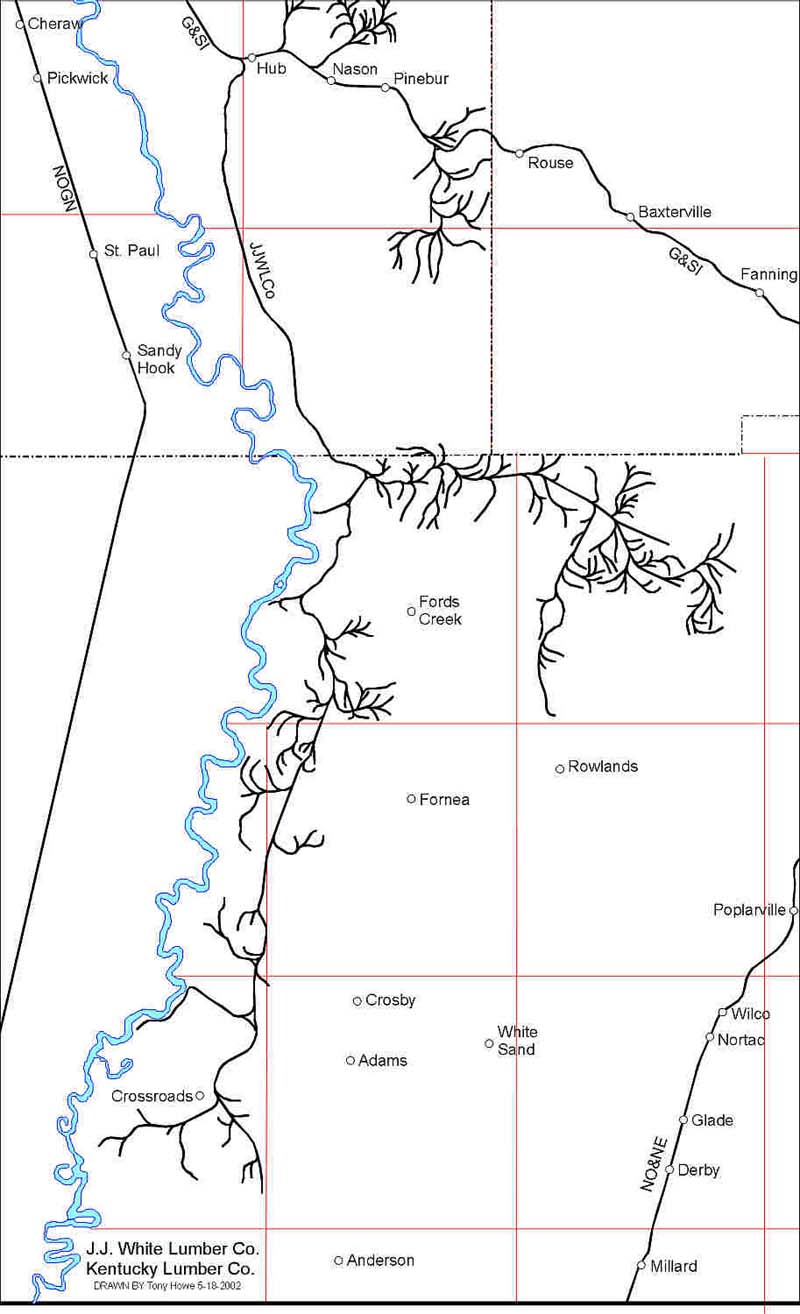
J. J. White Lumber Co.
Liberty-White
Railroad 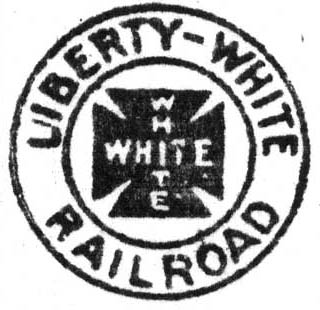
|
Standard and 36" Gauge Headquarters: South McComb, MS Officers (1907): J. J. White, President; W. M. White, Vice-president and Gen Mgr.; J. J. White, Jr., Sec.; H. L. White, Tres. Years of Operation: 1902-1921 Miles Operated: 1904-1907: 35.1 miles 1907-1912: 43.7 miles 1912-1918: 60 miles 1918-1921: 25 miles Locomotives Owned: 18 |
Equipment 1910- 5 locomotives, a mail and baggage car, 6 passenger cars, 1 passenger motor car, 2 cabooses, 4 tank cars and 14 box cars June 30, 1914- 2 locomotives, 5 passenger, 1 baggage, 12 box, 50 flats, 1 coal, 2 other, 1 service |

Click Map for Larger Version Google Earth Map HERE |
|
History by Tony Howe: The
Liberty-White Railroad, in Southwest Mississippi, was one of the more
unique shortline railroads in the state. In many ways, it was similar to
most of the smaller railroads of the state built to serve the lumber
industry at the time. The Liberty-White, however, seems to have had a
character all its own, and was notable for being the only shortline in
the state to operate both standard and narrow gauge lines at the same
time. The J. J. White Lumber Co., owner of the railroad, also had a
varied and interesting history. It was one of the longest-lasting
companies, and was one of the first in the state to build a logging
railroad. John J. White was born in Anderson County,
South Carolina, on April 1, 1830. When he was eight years old, White
moved with his family to Madison County, Mississippi. After teaching
school for a few years, J. J. White then became a carpenter. In 1859, J.
J. White decided to enter the lumber business, and together with his
brother, Robert E., started a small sawmill near Summit, Miss. This mill
ran until the outbreak of the War Between the States. J. J. White, although opposed to secession,
enlisted with the Confederate Army at the beginning of the war. He
served in Company H, Thirty-ninth Mississippi Regiment, and became a
Lieutenant in his company. He fought in the battles of Corinth,
Vicksburg, and Port Hudson. At the latter, he was taken prisoner and was
held in the military prison at Johnson’s Island, Ohio,
in Lake Erie, until the end of the war. After the War, J. J. White, forever known
as “Captain White,” returned to Summit and rebuilt his sawmill
business from the ground up. In 1873 he moved the plant south to McComb
City. The small town that grew up around the mill, located about a mile
south of McComb, became known as Whitestown. The depot built at this
location by the Illinois Central Railroad was simply dubbed South McComb.
To supply the mill with logs, a 36" gauge logging railroad was
built in 1879, and extending westward several miles into the timber. By
1891, this railroad had reached a length of 14 miles and extended into
Amite County. The first locomotive was a small 0-4-0 tank locomotive
bought new from Porter. A second Porter locomotive, an 0-6-2T, was added
in 1885, and Brooks-built 2-6-0 was bought from the Houston East &
West Texas RR in 1895. A Baldwin 2-8-0 was purchased from the Colorado
& Southern in 1901. When the land due west of McComb was all
cut over, the railroad was about to be abandoned and taken up when the
citizens of Liberty, seat of Amite County, persuaded J. J. White to
extend the railroad to their town. As a result, the Liberty-White
Railroad was chartered in Mississippi on December 22, 1902 and took over
the narrow gauge line of the J. J. White Company. The entire capital
stock of the Liberty-White Railroad, amounting to $300,000, was owned by
stockholders of the J. J. White Lumber Company. The Liberty-White Railroad added a third rail to the narrow gauge line from S. McComb a point known as Irene near the Pike-Amite County line. From this point, a standard gauge railroad was built westward to Liberty. The line was finally completed into Liberty and opened for business on July 20, 1904. The J. J. White 36" gauge logging railroad was built southwestward from Irene in 1900 into the southeastern corner of Amite Co. 10.1 miles to a point known as Keiths. This line, known as the Louisiana Division, was leased by Liberty-White from the parent lumber company for $300 a month. Logging spurs eventually extended from Keiths into the northern edge of St. Helena Parish, Louisiana. This narrow gauge line was also notable for having one of the few known points where two narrow gauge logging railroads crossed. At a point named Sandifer, this line was crossed by the 36" gauge logging railroad of A. W. Stevens Lumber Co. running westward from the Stevens mill just north of Chatawa. Instead of building a crossing diamond, two switches were used by the Stevens railroad to get across the J. J. White line, with Stevens log trains running a short distance over the White railroad. Upon completion of the Liberty-White into
Liberty, the lumber company started buying timberland northwest of
Liberty. Considerable timberland was eventually bought in northwestern
Amite Co. and southern Franklin Co., but it appears that an extension of
the logging railroad into this area was never built. Most of this land,
approximately 14,710 acres, was sold by the lumber company to the
Homochitto Lumber Co. on February 27, 1912. Timberland was also
purchased east of McComb, and a standard gauge railroad was built into
this timber. On January 1, 1907, the Liberty-White opened the line
between S. McComb and New Holmesville, a distance of 8.6 miles. Logging
spurs were built from New Holmesville northward to log timberland owned
by the J. J. White Lumber Co. between the Bogue Chitto River and Topisaw
Creek. In order to log in this more rugged area, the lumber company
purchased two Shay locomotives. A 2-truck 42-ton Shay was bought in
1908, and a 3-truck 70-ton Shay followed a year later. The Liberty-White
line was extended southeast from New Holmesville to Tylertown, and
opened on September 28, 1912. It downtown Tylertown, the railroad
connected with both the New Orleans Great Northern and Fernwood &
Gulf just east of their depots, near the crossing of these two
railroads. A deep cut was said to have been dug between buildings in
downtown Tylertown to reach this connection, as the downtown area is
located on a hill. J. J. White was not only involved in the
lumber company and railroad, but also other area enterprises. He was
president of the McComb City Bank, and organized the McComb Electric
Light & Power Co., the McComb Brick Co., the McComb Cotton Mill, and
a number of other enterprises. White also helped bail out his
son-in-law, J. H. Hinton, whenever the Camp & Hinton mill at
Lumberton ran into financial difficulties. White eventually purchased
the mill at Lumberton on October 12, 1893, but resold the property back
to the Camp & Hinton Co. on June 3, 1899. Capt. White’s sons,
William M., John, Jr., and Hugh White, became increasingly involved in
the various family businesses. When the J. J. White Lumber Co. was
formally incorporated on January 11, 1905, Hugh White was elected
president of the company. W. M. White served as general manager of the
Liberty-White RR. By the time J. J. White, Sr., passed away on November
16, 1912, the lumber company and railroad were already being run by his
sons. In 1910 the equipment of the Liberty-White
RR was listed as consisting of 5 locomotives, a mail and baggage car, 6
passenger cars, 1 passenger motor car, 1 caboose, 1 passenger caboose, 4
tank cars, 14 box cars, 50 flat cars, 85 log cars and camp and
construction cars, and 2 wreck and pile driving cars. No distinction was
made between which cars were narrow and which cars were standard gauge.
At that time, two passenger trains and two log trains were run each way
daily between McComb and Liberty, and a mixed train was run between
McComb and New Holmesville. Liberty-White charged the lumber company $5
per car to haul log cars from the connection of the log spurs to the
mill at South McComb. After almost four decades of operation, the
mill at McComb was rapidly depleting all available timber in that area.
In September 1911, the company bought 270 million feet of timber in
southern Marion Co. from Edward Lowe. It was speculated that the
Liberty-White Railroad would be extended from Tylertown to Columbia to
haul this timber to McComb. The decision was made that it would be more
economical to replace the aging mill at McComb with a new mill at
Columbia instead. The mill at McComb finally cut its last log on October
4, 1912. Despite being in poor health, the elder J. J. White was driven
down to the mill from his home to watch the last log go through the
mill. The new mill was built on the south side of
Columbia, and consisted of a circular mill capable of cutting 100,000
feet per day. This mill was placed in operation in February 1913. It was
eventually replaced by a band mill and a hardwood mill was also added.
Log trains were run over the Gulf & Ship Island Railroad from
Pinebur and Hub to the mill at Columbia. The first log camp was set up
near the G&SI main near the top of Hub Hill between Pinebur and the
Marion-Lamar County line. The camp was later moved to a point near Hub. Without the huge White sawmill at McComb,
the Liberty-White Railroad was faced with an uncertain future. The
narrow gauge line from Irene to Keiths was quickly abandoned
in 1912. On November 12, 1914 the railroad was placed in
receivership. The line from South McComb to Tylertown, 24.78 miles, was
abandoned on December 24, 1918 by authority of the State of Mississippi.
In May 1919 the remaining line was sold to pay off creditors. Under new
management the line from South McComb to Liberty was rehabilitated, but
again went into receivership. On September 23, 1921 all operations
ceased on this segment. Many miles of logging spurs were built out
of Hub to haul logs to the mill at Columbia. Initially, spurs were first
built northeastward. One of these eventually connected with the logging
railroad of the Helen White Lumber Co., whose railroad ran southwest
from their mill at Clyde, on the Mississippi Central Railroad, to near
the Marion-Lamar County line. Helen White Lumber Co. was also owned by
Hugh White, and was formed in 1921 when he purchased the Lamar Lumber
Co. properties, and operated until 1927. About 1924 a new logging
railroad was built by the J. J. White Lumber Co. southward from Hub into
timber owned by the company in northern Pearl River Co. In addition to
the pine cut in the northern part of the county, hardwood timber was cut
in the bottoms along the east side of the Pearl River as far south as
the Crossroads and Henleyfield area in Pearl River Co. At one time, a
connection was made with the logging railroad of the Goodyear Yellow
Pine Co. near Crosby. In February 1922, Hugh White purchased the
hardwood mill and holdings of Price Veneer & Lumber Co. at Columbia.
Included was a logging railroad running west from a point known as
Cody’s Spur on the G&SI in southern Lawrence Co. and a small 2-4-0
locomotive. In late 1928 the hardwood mill of J. J. White was leased to the Kentucky Lumber Company, of Sulligent, Alabama. Included in the deal was hardwood timber off of White timberlands, 2-8-0 #19, and the right to run log trains over the J. J. White logging railroad into Pearl River Co. The pine mill of the J. J. White Lumber Company at Columbia continued to run a few more years. It finally cut its last log on October 24, 1931. After this time, the railroad was abandoned and equipment sold off or scrapped. After more than 70 years of sawmilling, the J. J. White Lumber Co. finally came to an end. Hugh White went on to serve two terms as governor of Mississippi in the 1930's and 1950's. Today, there is little remaining to remind anyone of the great lumber empire built by Capt. J. J. White at either McComb or Columbia. The old cotton mill that was once served by a narrow gauge spur off of the L-W still stands abandoned in McComb. By some miracle, the old Liberty-White depot at New Holmesville still stands silently not far from the banks of the Bogue Chitto amidst tall pines that once lured its owners to the area.
|
||
|
Narrow gauge train at the Glading depot circa 1904. Note standard gauge ties with rails still spaced 36" apart. |
|
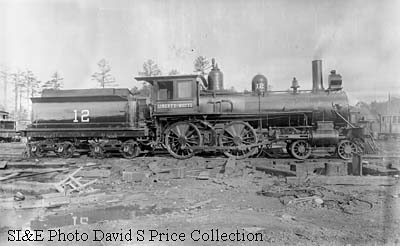
Southern Iron & equipment photo of Liberty-White #12 before delivery to McComb. |
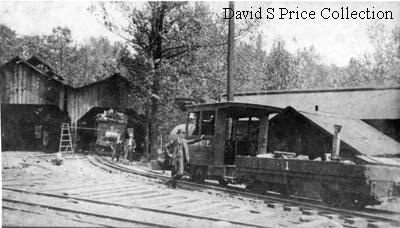
Liberty-White shops at South McComb with dual-gauge trackage. |
|
|
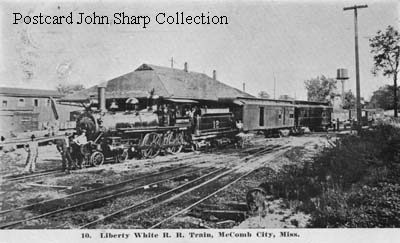
L-W #12 with passenger train at South McComb depot shared with Illinois Central. |
|
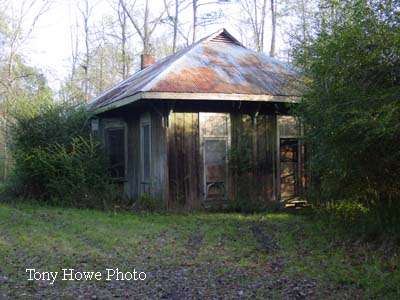
The Liberty-White depot at New Holmesville still stands. This section of the railroad was abandoned in 1918! |
|
"Capt." J. J. White |
Offices of Liberty-White Railroad, as well as the lumber company and other White-owned companies. Postcard from John Sharp Collection |
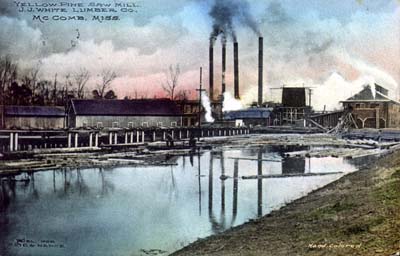
J. J. White Lumber Co. mill at South McComb. Postcard from John Sharp Collection |
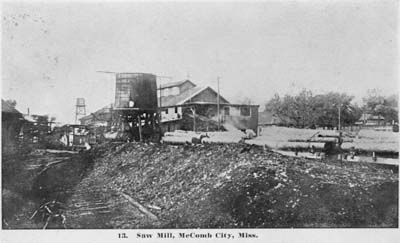
J. J. White McComb mill with No. 9 switching a log train. Postcard from John Sharp Collection |
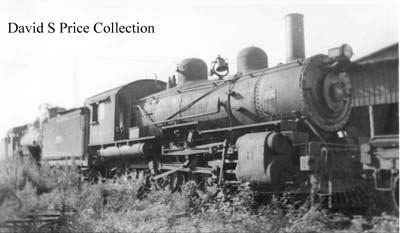
J. J. White Lumber Co. No. 90 at Columbia circa 1930. |
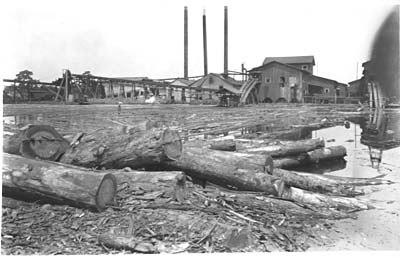
J. J. White Lumber Co. mill at Columbia. Columbia Chamber of Commerce |
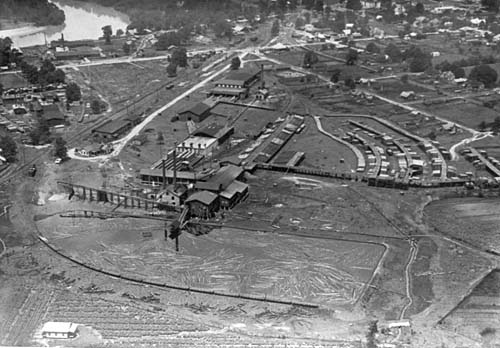
Aerial view of White mill in Columbia. Columbia Chamber of Commerce |
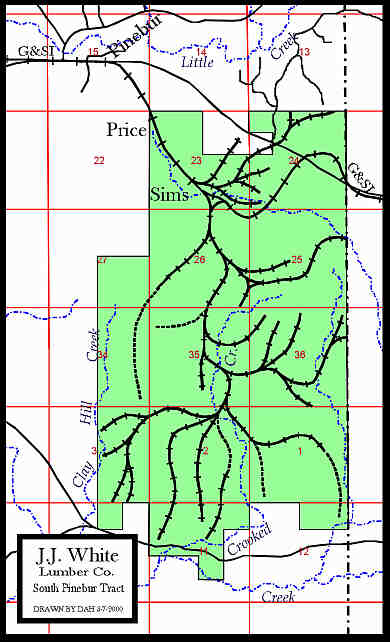
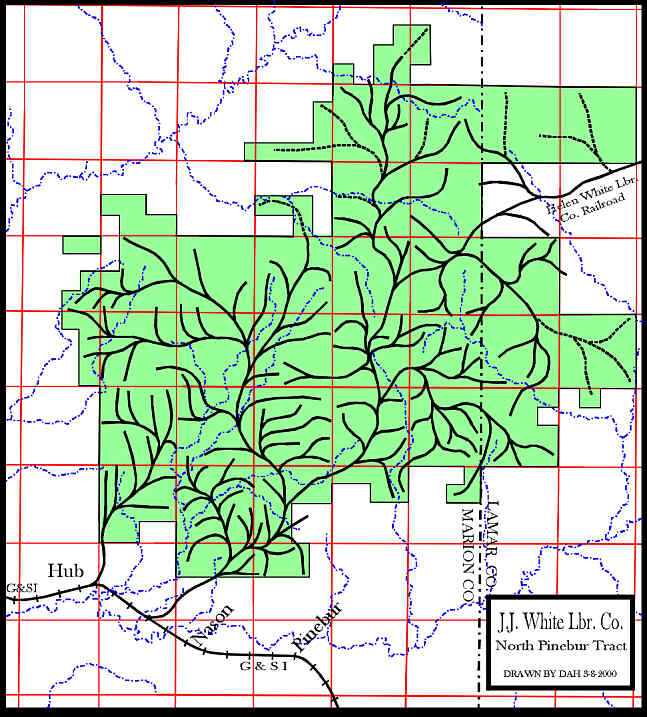
Click maps for larger versions |
Click map for larger version |
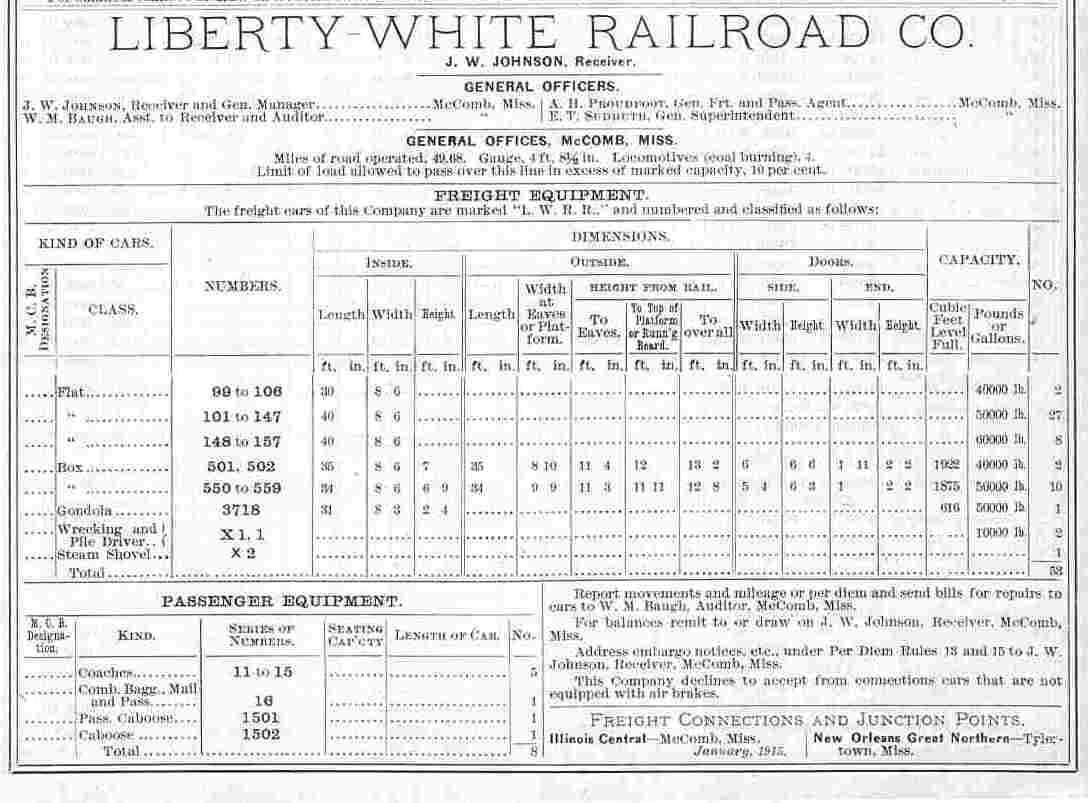 January 1915 Official Railway Equipment Register- Art Richardson Collection |
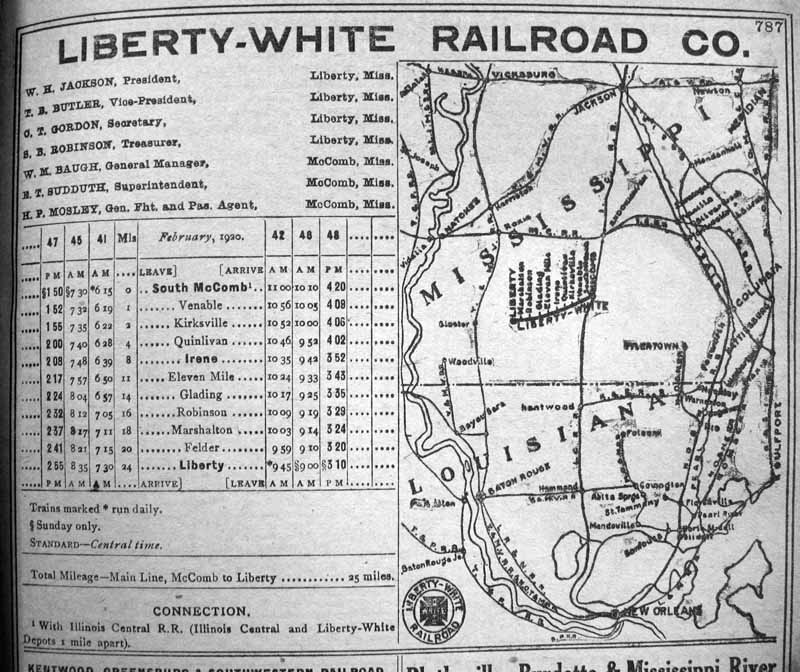 |
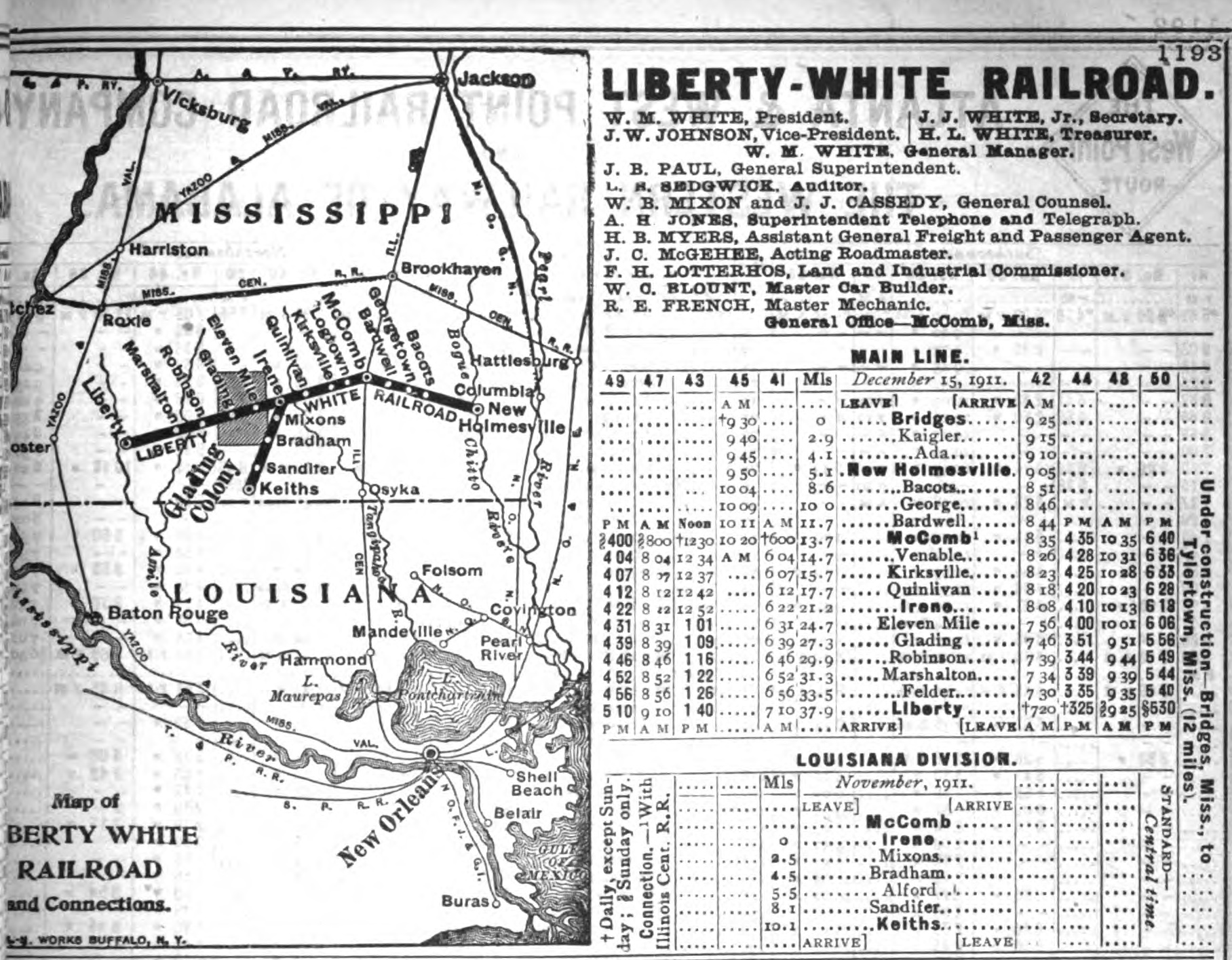 January 1912 Official Guide of the Railways |
For more information contact Tony Howe at tonyhowe76@yahoo.com or David S. Price at davidsprice46@gmail.com
All content on Mississippi Rails website is copyrighted by us or the individual or institution noted on the image or accompanying text. Please contact us below for permission to use any image or information contained on this website. Mississippi Rails is not affiliated with any railroad.
©2009 Mississippi Rails
